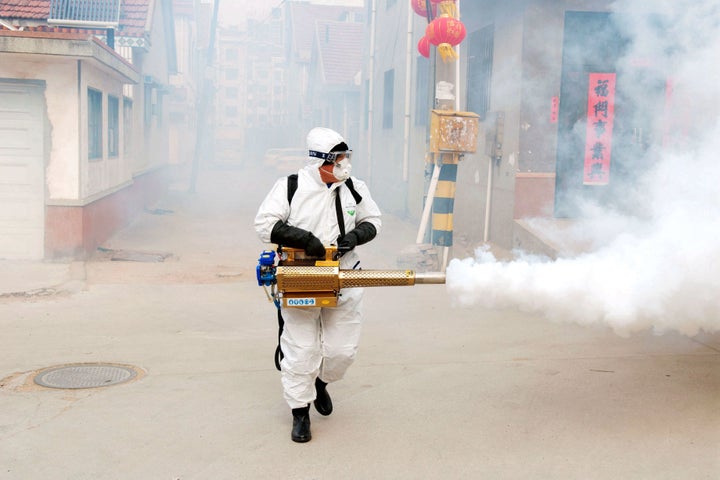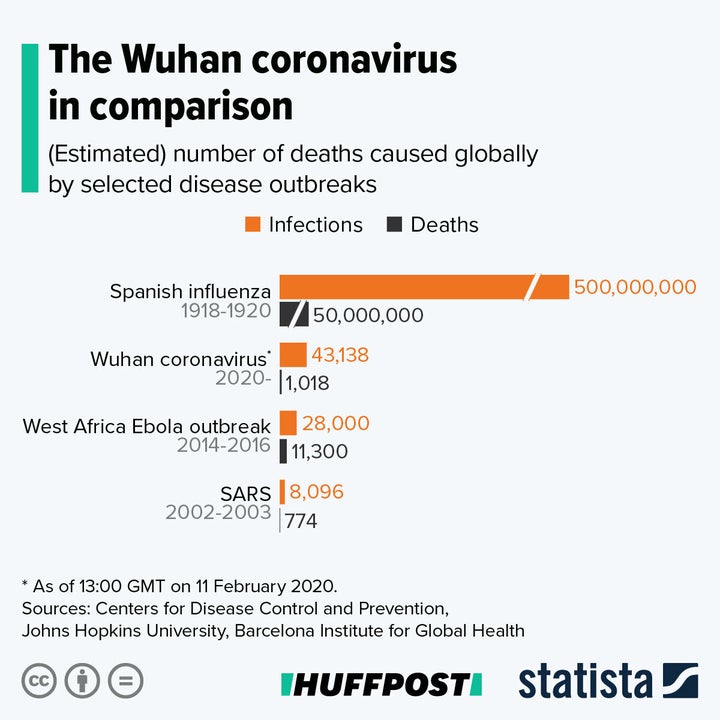The death toll from the coronavirus has risen to 1,018, and there are now 43,106 confirmed infections worldwide.
Governments around the world – including the UK – are scrambling to both prevent the disease spreading and to repatriate their citizens currently stranded in the Chinese city at the epicentre of the outbreak.
Four more patients in England tested positive for coronavirus on Monday, bringing the total number of cases in the UK to eight and two GP surgery branches in Brighton have been shut following an outbreak in the city.
Health secretary Matt Hancock announced new regulations on Monday “to ensure that the public are protected as far as possible from the transmission of the virus” – giving the government extra control to fight the spread of infection.
It will mean people can be forcibly quarantined and will not be free to leave.
All in all, there is quite the global crisis on the boil. But how bad is it really?

For context, here’s how it stacks up to previous deadly outbreaks.
Let’s start with the latest on coronavirus
At the time of writing, 1,018 people – all bar two in China – have died in the latest outbreak and there are about 43,106 reported cases of infection.
In Hong Kong, a 39-year-old man has become the first coronavirus death reported in the territory, and a 44-year-old man has died in the Philippines.
Around 470 cases have been reported in two dozen other countries.
The US, Japan, Singapore, Indonesia, New Zealand and Australia have imposed similar restrictions despite criticism from China and World Health Organisation’s (WHO) guidance that such measures were unnecessary.
Its symptoms, including cough and fever and in severe cases pneumonia, are similar to many other illnesses.
The director-general of the World Health Organisation said this week the agency is still unable to predict where the outbreak is heading but that he believes there is still an opportunity to contain it.
SARS
You may have noticed that coronavirus has been compared a lot to SARS, and for good reason: SARS was in fact a coronavirus.
Confused? Don’t be. Coronavirus is actually a family of viruses that includes the common cold.
This current outbreak of coronavirus was temporarily named “2019-nCoV” but that doesn’t roll off the tongue quite as easily, so the generic family name has stuck.
Severe Acute Respiratory Syndrome (SARS) was responsible for a global outbreak between November 2002 and July 2003. It was very similar to the current coronavirus. Crucially, while it was less infectious, it was also deadlier.
But the death toll from coronavirus has now surpassed SARS which only killed 774 people.

But it’s difficult to compare the number of deaths during the SARS outbreak after the same amount of time, as Chinese authorities withheld information – a lesson they appear to have learned this time around.
No further cases of SARS have been reported since 2004.
Ebola
While the symptoms of SARS and coronavirus could be confused with a case of the flu, those of ebola most certainly can not.
The virus severely affects the blood’s ability to clot, leading to often fatal uncontrolled bleeding.
As you can see from the chart above, it is far deadlier than coronavirus and during the West Africa outbreak between 2014-16 almost 50% of cases were fatal.
Only a global concerted effort led by the WHO stopped the virus from spreading beyond the African continent, although isolated cases such as Scottish nurse Pauline Cafferkey did slip through the net.
Spanish Influenza
To put all of these into perspective, it’s necessary to hark back to 1918.
Not only was humanity dealing with what was then by far the most deadly war in history, but an outbreak of influenza spread around the world and killed around 5% of the entire world’s population – some 50m people.
There was barely a corner of the world unaffected with cases reported on remote islands in the pacific and even the Arctic.
What was particularly terrifying about this strain of the flu virus was that it was especially lethal for those in the normally healthy age bracket of 20-40 years.
Medicine was obviously more primitive 100 years ago and there was no WHO to coordinate a response, but scientists still aren’t quite sure why it was so devastating.
Infographic supplied by Statista.
(CORRECTION: An earlier version of this article incorrectly stated total deaths during the Spanish influenza were around 500m. This should have been around 50m.)

